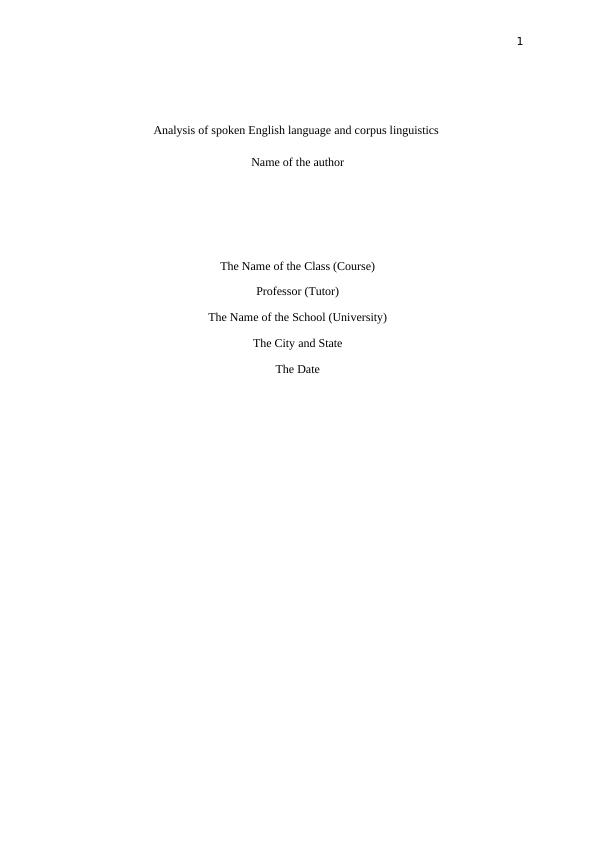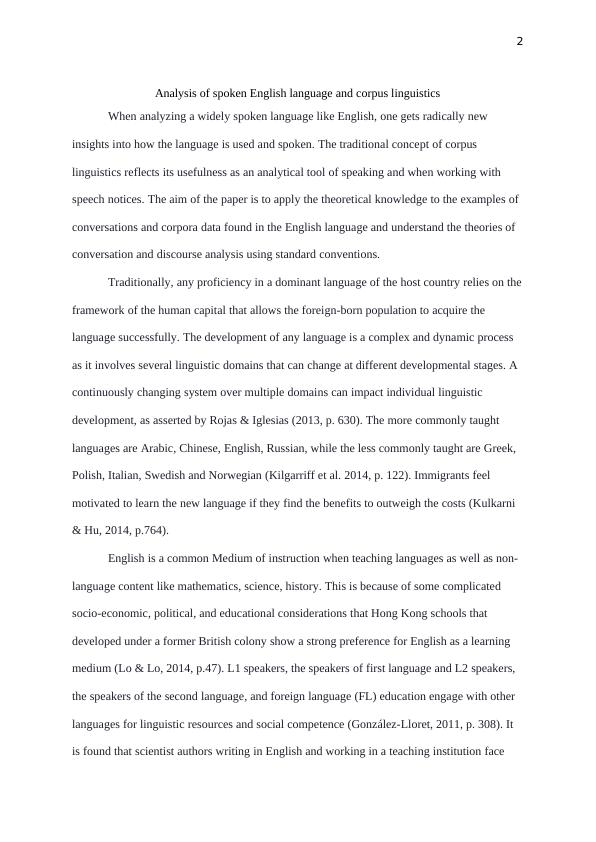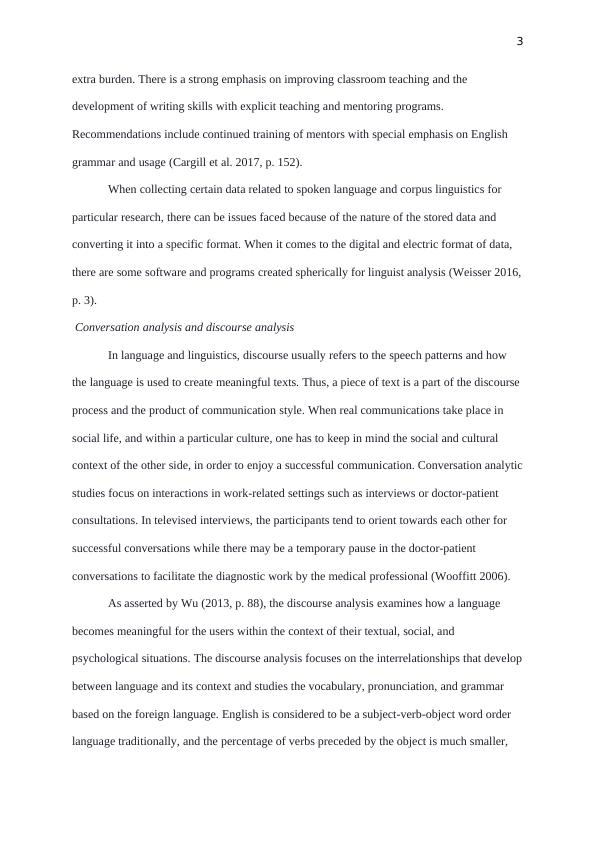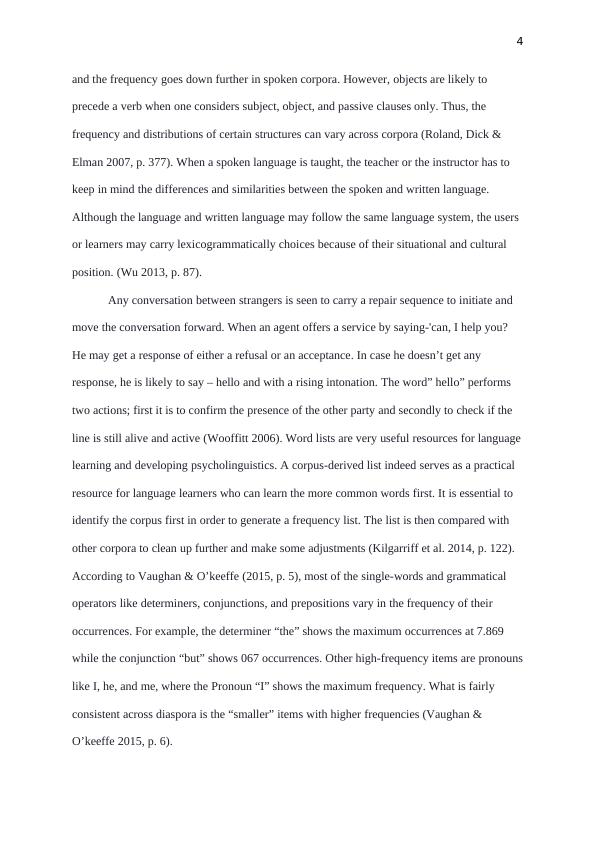Analysis of spoken English language and Corpus Linguistics
This essay analyzes spoken language using conversation analysis and corpus linguistics to reveal sub-conscious processes and understand how meaning is created in language.
13 Pages4323 Words60 Views
Added on 2022-08-26
Analysis of spoken English language and Corpus Linguistics
This essay analyzes spoken language using conversation analysis and corpus linguistics to reveal sub-conscious processes and understand how meaning is created in language.
Added on 2022-08-26
ShareRelated Documents
1
Analysis of spoken English language and corpus linguistics
Name of the author
The Name of the Class (Course)
Professor (Tutor)
The Name of the School (University)
The City and State
The Date
Analysis of spoken English language and corpus linguistics
Name of the author
The Name of the Class (Course)
Professor (Tutor)
The Name of the School (University)
The City and State
The Date

2
Analysis of spoken English language and corpus linguistics
When analyzing a widely spoken language like English, one gets radically new
insights into how the language is used and spoken. The traditional concept of corpus
linguistics reflects its usefulness as an analytical tool of speaking and when working with
speech notices. The aim of the paper is to apply the theoretical knowledge to the examples of
conversations and corpora data found in the English language and understand the theories of
conversation and discourse analysis using standard conventions.
Traditionally, any proficiency in a dominant language of the host country relies on the
framework of the human capital that allows the foreign-born population to acquire the
language successfully. The development of any language is a complex and dynamic process
as it involves several linguistic domains that can change at different developmental stages. A
continuously changing system over multiple domains can impact individual linguistic
development, as asserted by Rojas & Iglesias (2013, p. 630). The more commonly taught
languages are Arabic, Chinese, English, Russian, while the less commonly taught are Greek,
Polish, Italian, Swedish and Norwegian (Kilgarriff et al. 2014, p. 122). Immigrants feel
motivated to learn the new language if they find the benefits to outweigh the costs (Kulkarni
& Hu, 2014, p.764).
English is a common Medium of instruction when teaching languages as well as non-
language content like mathematics, science, history. This is because of some complicated
socio-economic, political, and educational considerations that Hong Kong schools that
developed under a former British colony show a strong preference for English as a learning
medium (Lo & Lo, 2014, p.47). L1 speakers, the speakers of first language and L2 speakers,
the speakers of the second language, and foreign language (FL) education engage with other
languages for linguistic resources and social competence (González-Lloret, 2011, p. 308). It
is found that scientist authors writing in English and working in a teaching institution face
Analysis of spoken English language and corpus linguistics
When analyzing a widely spoken language like English, one gets radically new
insights into how the language is used and spoken. The traditional concept of corpus
linguistics reflects its usefulness as an analytical tool of speaking and when working with
speech notices. The aim of the paper is to apply the theoretical knowledge to the examples of
conversations and corpora data found in the English language and understand the theories of
conversation and discourse analysis using standard conventions.
Traditionally, any proficiency in a dominant language of the host country relies on the
framework of the human capital that allows the foreign-born population to acquire the
language successfully. The development of any language is a complex and dynamic process
as it involves several linguistic domains that can change at different developmental stages. A
continuously changing system over multiple domains can impact individual linguistic
development, as asserted by Rojas & Iglesias (2013, p. 630). The more commonly taught
languages are Arabic, Chinese, English, Russian, while the less commonly taught are Greek,
Polish, Italian, Swedish and Norwegian (Kilgarriff et al. 2014, p. 122). Immigrants feel
motivated to learn the new language if they find the benefits to outweigh the costs (Kulkarni
& Hu, 2014, p.764).
English is a common Medium of instruction when teaching languages as well as non-
language content like mathematics, science, history. This is because of some complicated
socio-economic, political, and educational considerations that Hong Kong schools that
developed under a former British colony show a strong preference for English as a learning
medium (Lo & Lo, 2014, p.47). L1 speakers, the speakers of first language and L2 speakers,
the speakers of the second language, and foreign language (FL) education engage with other
languages for linguistic resources and social competence (González-Lloret, 2011, p. 308). It
is found that scientist authors writing in English and working in a teaching institution face

3
extra burden. There is a strong emphasis on improving classroom teaching and the
development of writing skills with explicit teaching and mentoring programs.
Recommendations include continued training of mentors with special emphasis on English
grammar and usage (Cargill et al. 2017, p. 152).
When collecting certain data related to spoken language and corpus linguistics for
particular research, there can be issues faced because of the nature of the stored data and
converting it into a specific format. When it comes to the digital and electric format of data,
there are some software and programs created spherically for linguist analysis (Weisser 2016,
p. 3).
Conversation analysis and discourse analysis
In language and linguistics, discourse usually refers to the speech patterns and how
the language is used to create meaningful texts. Thus, a piece of text is a part of the discourse
process and the product of communication style. When real communications take place in
social life, and within a particular culture, one has to keep in mind the social and cultural
context of the other side, in order to enjoy a successful communication. Conversation analytic
studies focus on interactions in work-related settings such as interviews or doctor-patient
consultations. In televised interviews, the participants tend to orient towards each other for
successful conversations while there may be a temporary pause in the doctor-patient
conversations to facilitate the diagnostic work by the medical professional (Wooffitt 2006).
As asserted by Wu (2013, p. 88), the discourse analysis examines how a language
becomes meaningful for the users within the context of their textual, social, and
psychological situations. The discourse analysis focuses on the interrelationships that develop
between language and its context and studies the vocabulary, pronunciation, and grammar
based on the foreign language. English is considered to be a subject-verb-object word order
language traditionally, and the percentage of verbs preceded by the object is much smaller,
extra burden. There is a strong emphasis on improving classroom teaching and the
development of writing skills with explicit teaching and mentoring programs.
Recommendations include continued training of mentors with special emphasis on English
grammar and usage (Cargill et al. 2017, p. 152).
When collecting certain data related to spoken language and corpus linguistics for
particular research, there can be issues faced because of the nature of the stored data and
converting it into a specific format. When it comes to the digital and electric format of data,
there are some software and programs created spherically for linguist analysis (Weisser 2016,
p. 3).
Conversation analysis and discourse analysis
In language and linguistics, discourse usually refers to the speech patterns and how
the language is used to create meaningful texts. Thus, a piece of text is a part of the discourse
process and the product of communication style. When real communications take place in
social life, and within a particular culture, one has to keep in mind the social and cultural
context of the other side, in order to enjoy a successful communication. Conversation analytic
studies focus on interactions in work-related settings such as interviews or doctor-patient
consultations. In televised interviews, the participants tend to orient towards each other for
successful conversations while there may be a temporary pause in the doctor-patient
conversations to facilitate the diagnostic work by the medical professional (Wooffitt 2006).
As asserted by Wu (2013, p. 88), the discourse analysis examines how a language
becomes meaningful for the users within the context of their textual, social, and
psychological situations. The discourse analysis focuses on the interrelationships that develop
between language and its context and studies the vocabulary, pronunciation, and grammar
based on the foreign language. English is considered to be a subject-verb-object word order
language traditionally, and the percentage of verbs preceded by the object is much smaller,

4
and the frequency goes down further in spoken corpora. However, objects are likely to
precede a verb when one considers subject, object, and passive clauses only. Thus, the
frequency and distributions of certain structures can vary across corpora (Roland, Dick &
Elman 2007, p. 377). When a spoken language is taught, the teacher or the instructor has to
keep in mind the differences and similarities between the spoken and written language.
Although the language and written language may follow the same language system, the users
or learners may carry lexicogrammatically choices because of their situational and cultural
position. (Wu 2013, p. 87).
Any conversation between strangers is seen to carry a repair sequence to initiate and
move the conversation forward. When an agent offers a service by saying-'can, I help you?
He may get a response of either a refusal or an acceptance. In case he doesn’t get any
response, he is likely to say – hello and with a rising intonation. The word” hello” performs
two actions; first it is to confirm the presence of the other party and secondly to check if the
line is still alive and active (Wooffitt 2006). Word lists are very useful resources for language
learning and developing psycholinguistics. A corpus-derived list indeed serves as a practical
resource for language learners who can learn the more common words first. It is essential to
identify the corpus first in order to generate a frequency list. The list is then compared with
other corpora to clean up further and make some adjustments (Kilgarriff et al. 2014, p. 122).
According to Vaughan & O’keeffe (2015, p. 5), most of the single-words and grammatical
operators like determiners, conjunctions, and prepositions vary in the frequency of their
occurrences. For example, the determiner “the” shows the maximum occurrences at 7.869
while the conjunction “but” shows 067 occurrences. Other high-frequency items are pronouns
like I, he, and me, where the Pronoun “I” shows the maximum frequency. What is fairly
consistent across diaspora is the “smaller” items with higher frequencies (Vaughan &
O’keeffe 2015, p. 6).
and the frequency goes down further in spoken corpora. However, objects are likely to
precede a verb when one considers subject, object, and passive clauses only. Thus, the
frequency and distributions of certain structures can vary across corpora (Roland, Dick &
Elman 2007, p. 377). When a spoken language is taught, the teacher or the instructor has to
keep in mind the differences and similarities between the spoken and written language.
Although the language and written language may follow the same language system, the users
or learners may carry lexicogrammatically choices because of their situational and cultural
position. (Wu 2013, p. 87).
Any conversation between strangers is seen to carry a repair sequence to initiate and
move the conversation forward. When an agent offers a service by saying-'can, I help you?
He may get a response of either a refusal or an acceptance. In case he doesn’t get any
response, he is likely to say – hello and with a rising intonation. The word” hello” performs
two actions; first it is to confirm the presence of the other party and secondly to check if the
line is still alive and active (Wooffitt 2006). Word lists are very useful resources for language
learning and developing psycholinguistics. A corpus-derived list indeed serves as a practical
resource for language learners who can learn the more common words first. It is essential to
identify the corpus first in order to generate a frequency list. The list is then compared with
other corpora to clean up further and make some adjustments (Kilgarriff et al. 2014, p. 122).
According to Vaughan & O’keeffe (2015, p. 5), most of the single-words and grammatical
operators like determiners, conjunctions, and prepositions vary in the frequency of their
occurrences. For example, the determiner “the” shows the maximum occurrences at 7.869
while the conjunction “but” shows 067 occurrences. Other high-frequency items are pronouns
like I, he, and me, where the Pronoun “I” shows the maximum frequency. What is fairly
consistent across diaspora is the “smaller” items with higher frequencies (Vaughan &
O’keeffe 2015, p. 6).

End of preview
Want to access all the pages? Upload your documents or become a member.
Related Documents
ESP in the Legal Profession: Strategies for Needs Analysis and Teaching Reading and Listening Skillslg...
|19
|5022
|257
